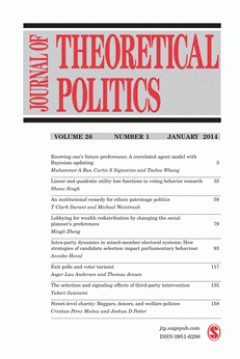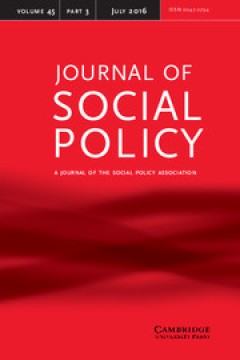Filter by

Are social mechanisms usable and useful in evaluation research?
This article reflects on the potential contribution of a social mechanism approach to evaluation research, based on the empirical analysis of three evaluations of European policies. A methodological framework for carrying out evaluation based on this approach is put forward that help identify questions to be answered and steps in a working method to be followed. More specifically, the a…
- Edition
- Volume 22, Issue 2, April 2016; pp. 209–227
- ISBN/ISSN
- 13563890
- Collation
- -
- Series Title
- Evaluation
- Call Number
- -

Evaluation in management by objectives: A critical analysis of Sweden’s n…
This article investigates what can be achieved by one particular management by objectives system � i.e. the Swedish National Environmental Quality Objectives system and its evaluation function. A critical programme theory analysis is first developed to reconstruct the programme theory of the National Environmental Quality Objectives system. Next, the robustness of the programme theory i…
- Edition
- Volume 22, Issue 2, April 2016, 2016; pp. 190–208
- ISBN/ISSN
- 13563890
- Collation
- -
- Series Title
- Evaluation
- Call Number
- -

Evaluation units as knowledge brokers: Testing and calibrating an innovative …
Evaluation units, located within public institutions, are important actors responsible for the production and dissemination of evaluative knowledge in complex programming and institutional settings. The current evaluation literature does not adequately explain their role in fostering better evaluation use. The article offers an empirically tested framework for the analysis of the role o…
- Edition
- Volume 22, Issue 2, April 2016; pp. 168–189
- ISBN/ISSN
- 13563890
- Collation
- -
- Series Title
- Evaluation
- Call Number
- -

Using Contribution Analysis to evaluate small & medium enterprise support po…
This research illustrates a pragmatic approach to evaluating the small and medium sized enterprise policy support in small or intermediate N research situations. A public interest perspective is taken. The suggested approach is most appropriate in settings where, for a variety of reasons, a study is unable to meet the requirements of a true experimental design (e.g. random assignment, e…
- Edition
- Volume 22, Issue 2, April 2016; pp. 129–148
- ISBN/ISSN
- 13563890
- Collation
- -
- Series Title
- Evaluation
- Call Number
- -

Journal of Theoretical Politics, Volume 28, Number 3, July 2016
- Edition
- -
- ISBN/ISSN
- 0951-6298
- Collation
- -
- Series Title
- -
- Call Number
- -
- Edition
- -
- ISBN/ISSN
- 0951-6298
- Collation
- -
- Series Title
- -
- Call Number
- -

Journal of Theoretical Politics, Volume 28, Number 2, April 2016
- Edition
- -
- ISBN/ISSN
- 0951-6298
- Collation
- -
- Series Title
- -
- Call Number
- -
- Edition
- -
- ISBN/ISSN
- 0951-6298
- Collation
- -
- Series Title
- -
- Call Number
- -

Evaluation : The International Journal of Theory Research and Practice, Volum…
- Edition
- -
- ISBN/ISSN
- 13563890
- Collation
- -
- Series Title
- -
- Call Number
- -
- Edition
- -
- ISBN/ISSN
- 13563890
- Collation
- -
- Series Title
- -
- Call Number
- -

Critical Social Policy, Volume 36, Number 3, Issue 128, August 2016
- Edition
- -
- ISBN/ISSN
- 02610183
- Collation
- -
- Series Title
- -
- Call Number
- -
- Edition
- -
- ISBN/ISSN
- 02610183
- Collation
- -
- Series Title
- -
- Call Number
- -

To what Extent do Australian Health Policy Documents address Social Determi…
Evidence on social determinants of health and health equity (SDH/HE) is abundant but often not translated into effective policy action by governments. Governments� health policies have continued to privilege medical care and individualised behaviour-change strategies. In the light of these limitations, the 2008 Commission on the Social Determinants of Health called on health agencies to…
- Edition
- Volume 45 - Issue 3 - July 2016, pp. 545-564
- ISBN/ISSN
- 0047-2794
- Collation
- -
- Series Title
- Journal of Social Policy
- Call Number
- -

Payday lending in the UK: the regul(aris)ation of a necessary evil?
Concern about the increasing use of payday lending led the UK's Financial Conduct Authority to introduce landmark reforms in 2014/15. While these reforms have generally been welcomed as a way of curbing �extortionate� and �predatory� lending, this paper presents a more nuanced picture based on a theoretically-informed analysis of the growth and nature of payday lending combined with ori…
- Edition
- Volume 45 - Issue 3 - July 2016, pp. 527-543
- ISBN/ISSN
- 0047-2794
- Collation
- -
- Series Title
- Journal of Social Policy
- Call Number
- -

They really get you motivated’: Experiences of a life-first employment prog…
Long-term unemployment can negatively impact health and well-being, and is a central focus of governments seeking to address poverty and social exclusion. Little is known about how individuals experience programmes aimed at addressing long-term unemployment and consequently the client-centred indicators of �success�. In-depth interviews were carried out with 31 long-term unemployed indi…
- Edition
- Volume 45 - Issue 3 - July 2016, pp. 507-526
- ISBN/ISSN
- 0047-2794
- Collation
- -
- Series Title
- Journal of Social Policy
- Call Number
- -

Adaptation under Scrutiny: Peering Through the Lens of Community Governance i…
This paper examines processes of adaptive governance and authoritarian resilience through the lens of community governance, bringing together hitherto unrelated fields of study. It argues first that adaptation has unintended consequences that can threaten stability but do not necessarily cause regime crisis. Second, it contends that the structural fault-lines of institutionalised catego…
- Edition
- Volume 45 - Issue 3 - July 2016, pp. 487-506 Abstr
- ISBN/ISSN
- 0047-2794
- Collation
- -
- Series Title
- Journal of Social Policy
- Call Number
- -

International Charitable Connections: the Growth in Number, and the Countri…
This paper provides new empirical evidence about English and Welsh charities operating internationally. It answers basic questions unaddressed in existing work: how many charities work overseas, and how has this number changed over time? In which countries do they operate, and what underlies these geographical patterns? It makes use of a unique administrative dataset which records every…
- Edition
- Volume 45 - Issue 3 - July 2016, pp. 453-486 Abstr
- ISBN/ISSN
- 0047-2794
- Collation
- -
- Series Title
- Journal of Social Policy
- Call Number
- -

Rethinking Child Policy Post-UN Convention on the Rights of the Child: Vuln…
The UN Convention on the Rights of the Child (CRC) formulates the rights of children in terms of provision, protection and participation. CRC implies a multi-dimensional view of children's welfare, including agency. This enables us to rethink the way we research and design policies aimed at promoting child welfare. In the past, Sweden has been seen as a forerunner when it comes to child…
- Edition
- Volume 45 - Issue 3 - July 2016, pp. 435-452 Abstr
- ISBN/ISSN
- 0047-2794
- Collation
- -
- Series Title
- Journal of Social Policy
- Call Number
- -

Work Enforcement in Liberal Democracies
The paper aims to contribute to the normative debate concerning work enforcement in liberal democracies. In the late 1980s, OECD countries began to revert to the pre-welfare- state tradition of attributing unemployment to personal failure. The new welfare-to-work policies emphasised individual responsibility for securing employment. Stepping up job search requirements and sanctions for f…
- Edition
- Volume 45 - Issue 3 - July 2016, pp. 417-434
- ISBN/ISSN
- 0047-2794
- Collation
- -
- Series Title
- Journal of Social Policy
- Call Number
- -

Earned Citizenship: Labour Migrants’ Views on the Welfare State
In policy and research, migration and the welfare state are often seen as being at odds. When �strangers� enter the welfare state, the financial and social foundations of solidarity are said to crumble. A prominent question, therefore, is whether immigrants should have the same rights as the autochthonous population. Within this frame, migrants are often �objects�. This paper reports on…
- Edition
- Volume 45 - Issue 3 - July 2016, pp. 395-415 Abstr
- ISBN/ISSN
- 0047-2794
- Collation
- -
- Series Title
- Journal of Social Policy
- Call Number
- -

Social Quality and Work: What Impact Does Low Pay Have on Social Quality?
Using Confirmatory Factor Analysis models in conjunction with the British Household Panel Survey (BHPS) this paper reports the first application of the concept of Social Quality to a UK data set. Social Quality is concerned with the quality of society, or social relations, and consists of both a theoretical model and an empirically tested set of measures. Social Quality is explored in relation …
- Edition
- Volume 45 - Issue 2 - April 2016, pp. 345-371
- ISBN/ISSN
- 0047-2794
- Collation
- -
- Series Title
- Journal of Social Policy
- Call Number
- -

Constructing new global models of social security: How international organiza…
Social cash transfers to the poor have mushroomed in countries of the global South and on global agendas since the 2000s. Around 2000, there was no clear picture if social cash transfers would make it to global agendas. By the end of the 2000s, a repertoire of four models of social cash transfers had been codified by international organizations. Based on an in-depth analysis of all major docume…
- Edition
- Volume 45 - Issue 2 - April 2016, pp. 325-343
- ISBN/ISSN
- 0047-2794
- Collation
- -
- Series Title
- Journal of Social Policy
- Call Number
- -

Private Schools and the Provision of ‘Public Benefit’
Legislative changes and a recent court ruling allow private schools in England and Wales to determine how to provide the public benefits required to justify their charitable status. We investigate how private school headteachers and other informed stakeholders perceive their public benefit objectives and obligations. We find that schools interpret public beneficiaries widely to include one or m…
- Edition
- Volume 45 - Issue 2 - April 2016, pp. 305-323
- ISBN/ISSN
- 0047-2794
- Collation
- -
- Series Title
- Journal of Social Policy
- Call Number
- -

Street-level Practice of Russia's Social Policymaking in Saint Petersburg: Fe…
Despite the growth in studies of Russian social policy, the reality of the social policy process � most of which is regionally based � remains a puzzle. In this article, we stake a claim for the importance of studying street-level social service provision in Russia's regions to advance the understanding of social policymaking in authoritarian-leaning regimes. We show that � albeit in small ways…
- Edition
- Volume 45 - Issue 2 - April 2016, pp. 287-304
- ISBN/ISSN
- 0047-2794
- Collation
- -
- Series Title
- Journal of Social Policy
- Call Number
- -
 Computer Science, Information & General Works
Computer Science, Information & General Works  Philosophy & Psychology
Philosophy & Psychology  Religion
Religion  Social Sciences
Social Sciences  Language
Language  Pure Science
Pure Science  Applied Sciences
Applied Sciences  Art & Recreation
Art & Recreation  Literature
Literature  History & Geography
History & Geography